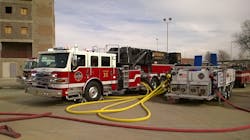Our apparatus are integral to our daily functions. They serve a variety of functions and, beyond the firefighters themselves, are the key factor to any successful operation. It’s no surprise then that our apparatus are highly expensive and technical pieces of machinery and, as such, require constant maintenance and upkeep to ensure that they can perform how we—and the members of the community—expect them to perform. This is what makes the preventive maintenance so important. The one crucial thing about preventive maintenance is that it will most likely reduce or eliminate the need for expensive corrective maintenance in the future.
Understanding the idea
When talking about preventive maintenance, we must first understand what that term means. According to the NFPA 1911: Standard for the Inspection, Maintenance, Testing, and Retirement of In-Service Automotive Fire Apparatus, preventive maintenance is the “systematic inspection, detection, correction, and prevention of incipient failures, before they become actual or major failures.”
Developing a program
Now that preventive maintenance has been defined, you can now move forward to set up a program that will fit the needs of your department. The NFPA provides an overview of how to set up a preventive maintenance program, along with sample preventive maintenance sheets (NFPA 1911 Annex C).
A few things that must be considered when starting a preventive maintenance program:
- The number of apparatus in the fleet
- The types of apparatus in the fleet
- The number of reserve apparatus that will be needed
- The type of NFPA annual testing that is required for the in-service apparatus
Once your fleet has been evaluated, you now need to determine where to have the maintenance done. You may use your own internal fire department shop, municipal or city shop, or a private heavy-duty truck shop. Regardless of which type of shop you choose to use, you must ensure that qualified personnel are completing the maintenance and repairs.
What makes for a “qualified person”? According to the NFPA 1071: Standard for Emergency Vehicle Technician Professional Qualifications, a qualified person is, “A person who, by possession of a recognized degree, certificate, professional standing, or skill, and who by knowledge, training, and experience, has demonstrated the ability to deal with problems related to the subject matter, the work, or project.” The NFPA provides an overview of technician qualifications (NFPA 1071 Annex C). Further, the following are the skills, certificates or other qualifications you should look for when choosing a shop or a technician:
- ASE certifications
- EVT certifications
- Technical schooling (i.e., associate’s degree in automotive tech)
- Engine and or manufacture certifications
- Certified welder
You may also choose to set your own minimum qualifications for the technician in your fire department shop or private shop that you may use. For example, you may require your technicians to have a minimum certification level with either ASE or EVT to perform preventive maintenance on your apparatus. The one thing that is often forgotten is whether your local laws and regulations require certain minimum qualifications for technicians to repair and maintain fire apparatus.
After selecting your shop and or internal personnel to perform your preventive maintenance, you now need some sort of software to help with tracking and creating your maintenace check forms. With so many systems on the market, you must decide how in-depth you need to be. For example, a smaller department with only a few pieces of apparatus will have a different set of needs than a larger department that will be expected to provide extensive reports or more detailed tracking. Software will track items like:
- Preventive maintenance due or overdue status
- Fuel tracking
- Annual testing
- Third-party certification testing
- Mileage
Another thing to consider in your maintenace program is documentation. You will need to know your local requirements or statutes regarding how long apparatus records must be kept. For instance, some states require departments to keep the records for the life of the apparatus, or one year after the apparatus is liquidated. Remember, if it is not documented, it did not happen.
Closing thoughts
When starting a preventive maintenace program at your department, keep in mind that we are risk managers, ultimately responsible for the two most important and valuable assets of the fire department—the men and women who operate/respond in the apparatus we maintain, and the apparatus itself. This is why it is so important to have a maintenace program in place with qualified and skilled personnel performing the maintenance and repairs. The last thing any of us wants is to be on the 5 o’clock news because of an apparatus failure that could have been prevented.
Michael Adams
Michael Adams is the fleet operations supervisor for South Metro Fire Rescue in Centennial, CO. He is an ASE master-certified heavy-truck technician, master-certified EVT fire apparatus and master-certified ARFF technician. Adams also holds an ASE advanced level certification in electronic diesel engine diagnostics, and holds an EVT Level 1 management supervisor. He has an associate’s degree of applied science, and is currently pursuing a bachelor’s degree in business. Adams has been an EVT for 11 years and a heavy-truck technician for 20 years. He was selected as Firehouse’s 2015 Emergency Vehicle Technician of the Year.






